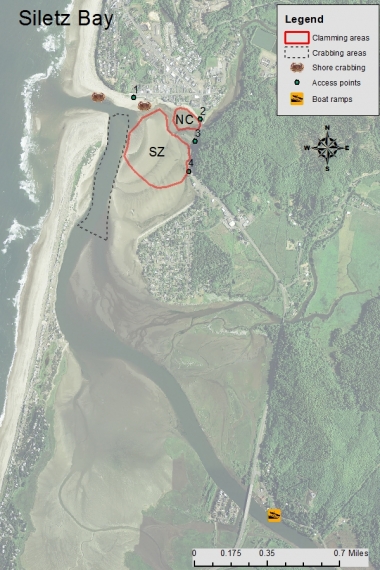
Where to crab & clam in Siletz Bay
Siletz Bay, located at the south end of Lincoln City, is a very popular destination for beach-goers and clam diggers. Some of the highest density purple varnish clam beds are easily accessed here. Its proximity to the ocean also makes it a very productive seasonal crabbing area

General crab and clam map
Areas
North of Schooner Creek (NC)
Beds of purple varnish clams can be found here.
Siletz Bay bed (SZ)
Beds of purple varnish clams can be found here, softshell clams may be interspersed.
Detailed clamming maps
The ODFW SEACOR project
The ODFW SEACOR project conducts bay clam population and habitat studies in the bays along the coast of Oregon. A primary focus is to document the abundance and preferred habitat of several popular bay clam species. These include butter clams, cockle clams, gaper clams, and native littleneck clams.
SEACOR is funded by recreational shellfish license fees, meaning that clammers and crabbers are directly contributing to research on the resources they enjoy.
To learn more about SEACOR, and find additional detailed clamming maps for Tillamook, Netarts, Siletz, Yaquina, Alsea, and Coos bays, visit the SEACOR web page.
Boat launches
Siletz Bay
Located off Hwy 229 (Siletz Hwy), just east of Hwy 101 at Kernville.
Information provided is a result of ODFW creel and population surveys, spot checks, and input from local residents. The purpose of this map is to provide the user with information and locations of recreational shellfish areas where the most likelihood of success may be found by species. Clam species identified within a particular area represent the most abundant found; other species may be present or may exist in areas not identified on the map. This is to be used as a reference as sandbars, clam beds, and species composition can shift over time. Always use caution when boating/crabbing in the lower bay as swift currents during tidal exchanges can occur, and result in loss of gear or cause boat to be pulled out to sea if mechanical problems arise. Developed 2014.
Header image by Peter Persall, US Fish and Wildlife Service



